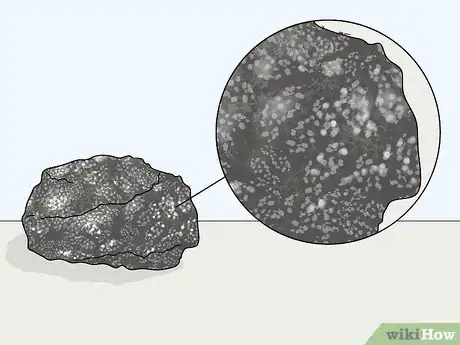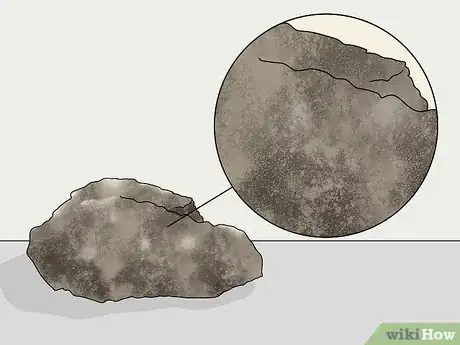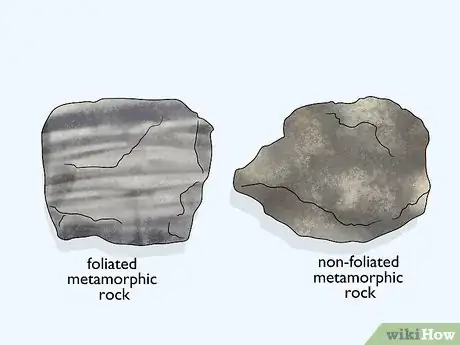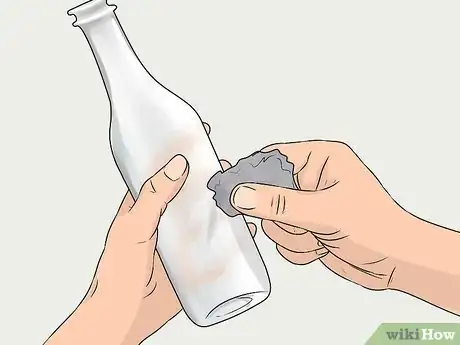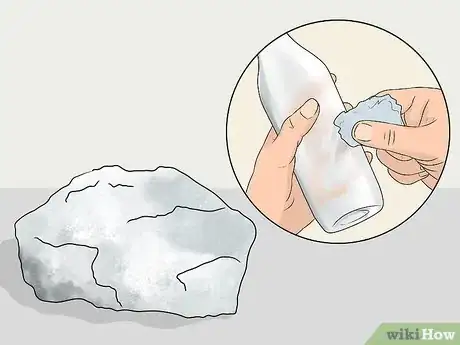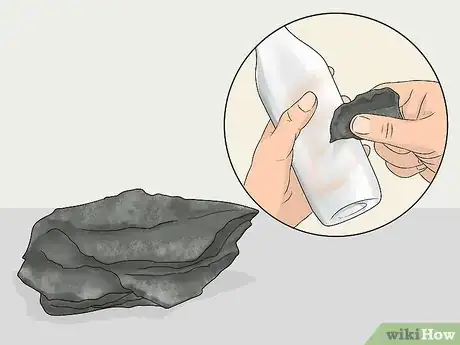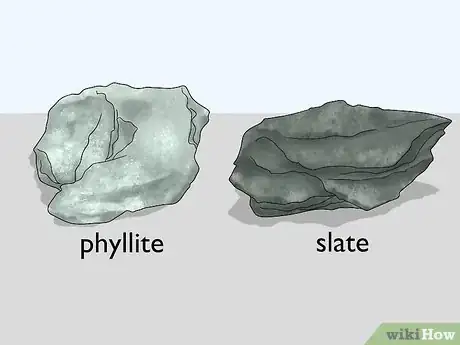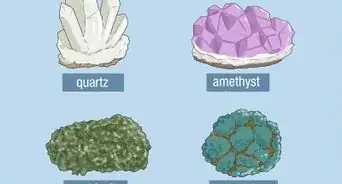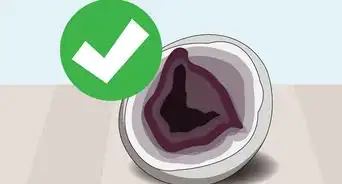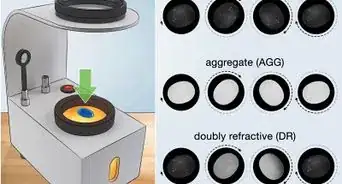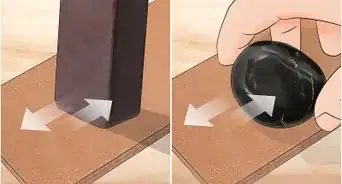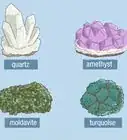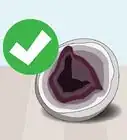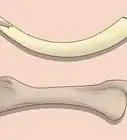This article was co-authored by Sam Lagor, MSc. Sam Lagor is a Geologist with over eight years of experience. He specializes in engineering geology (dams, bridges, and tunnels) and mineral exploration (gold, lead/zinc, andindustrial minerals). Sam holds a BS in Geology from St. Lawrence University and an MS in Geology from The University of Vermont. He is also a member of the Geological Society of America and the American Institute of Professional Geologists.
This article has been viewed 18,271 times.
Metamorphic rocks are formed through immense pressure and heat below the surface of the earth. Many rocks used in architecture and design are metamorphic, like slate and marble. Determining whether a rock is metamorphic, as opposed to igneous or sedimentary, can be difficult. With close attention to the grains and crystals that make up metamorphic rocks, you’ll be able to distinguish them from igneous and sedimentary rocks, and then figure out what kind of metamorphic rock it is.
Steps
Determining Whether a Rock is Metamorphic
-
1Hold the rock to the light and see if it has a shine or shimmer. Metamorphic rocks tend to have more luster than igneous or sedimentary rock. In the light, you should be able to tell whether the rock has an overall shimmery quality to it.[1]
- Not all metamorphic rocks have luster or shiny grains. “Non-foliated” rocks are often opaque and dull in color.
-
2Check for stripes and bands. If you notice any major striations in the rock, you are likely dealing with metamorphic rock. These bands might be very slight, but they will look either like clearly defined ribbons or crystals that appear to form slight “veins” throughout the rock.[2]
- These aren’t like the layers of sedimentary rock, which have a texture to them, and appear as though the rock is made of stacked pieces.
Advertisement -
3Look for large patches of reflective dots. Spots in the rock that have lots of tiny, reflective dots are suggestive of metamorphic rock. Aside from the general shimmery quality, metamorphic rocks often have a great deal of small reflective flecks. These are flecks of glittery crystal, not the quality shine of a precious metal or mineral.[3]
- If you can’t discern the smaller flecks, you can use a magnifier to see them in more detail.
- Metamorphic rocks like granite don’t have bands, but they do have remarkably concentrated amounts of crystals.
-
4Watch for any grainy textures in the rock. Most metamorphic rocks will have a significant amount of visible grains, with the exception of slate and a handful of rarer forms of metamorphic rock. These will not necessarily be reflective in the way crystals are, but they will have a rough appearance and texture.[4]
- Slate is a particularly tricky rock, as it has many features in common with sedimentary rocks.
-
5Look for organized patterns in the grains. Watch for patches of rock that seem to line up with each other more than the rest of the rock. Pay very close attention to the grains to see if there is a pattern aside from the more obvious stripes and bands.[5]
- If the grains seem to be organized more heavily in one are than another, or seem to “flow” evenly around the rock, it is likely metamorphic.
Identifying the Kind of Metamorphic Rock
-
1Use the bands to determine if the rock is foliated or non-foliated. There are two main categories of metamorphic rock: foliated and non-foliated. Foliated rocks have the stripes or bands that are often associated with metamorphic rocks, while non-foliated rocks lack this distinguishing feature.[6]
- The stripes or bands may be difficult to see, so be sure to look closely for any directions that crystals seem to be oriented in.
- Common foliated metamorphic rocks include slate, phyllite, and gneiss.
- Two common non-foliated metamorphic rocks are marble and quartzite.
-
2Identify quartzite by its pale or translucent color. If the rock has a pale color to it that is almost see-through in some areas, it may be quartzite. Quartz crystals are almost clear, and they tend to stay that way after metamorphosis. Quartzite is non-foliated, so you won’t see any bands or stripes in the rock.[7]
- The paleness of quartzite often appears almost yellow in color, due to chemical discoloration and impurities in the rock.
-
3See if the rock is gneiss by checking for light and dark bands. Bands or foliations that seem almost perfectly black and white are indicative of gneiss. Gneiss is composed of clear quartz and darker crystals, leading to remarkably differentiated striations. Less distinguishable bands suggest that the rock may be another kind.[8]
- A gneiss rock will have a grey hue to it overall, with the dark and light strikes cutting through the gray coloration.
-
4Scratch the rock against a glass bottle to determine its softness. Gently streak the rock against glass that you are holding firmly in place. If you can’t leave a scratch mark on glass with the rock, you are probably working with slate, marble, or phyllite. Each of these metamorphic rocks is soft enough that it can’t scratch glass when applied at a mild pressure. Gneiss and quartzite, however, can both scratch glass with very little force.[9]
- You only need to streak the rock against roughly 2 millimetres (0.079 in) of glass.
-
5Identify marble by looking for grains that seem to have no pattern. If the rock can’t scratch glass, is clearly metamorphic, but the grains don’t seem to have any clear orientation or pattern, you are most likely working with marble. Marble found in nature often looks less “pure” than the kind of marble seen in buildings and statues, which can be confusing at first.[10]
- The key to identifying marble is noticing the large crystals that seem randomly distributed, since it is a non-foliated form of metamorphic rock.
- Marble can vary widely in color, but the most common colors are white and grey.
-
6Check whether the rock is slate by looking for flat sheet layers. If the rock can’t cut glass and has rough edges that appear like sheets of rock, it is almost certainly slate. You should be able to see the clearly divided sheets within the rock itself, which are considered foliations, though they do not look like the bands in gneiss.[11]
- Slate is typically gray, black, or green. The gray color is a distinctive shade, often called “slate.”
- The layers in slate are not formed from sedimentation, but from the organization of crystal molecules into a straight line under immense pressure.
-
7Distinguish phyllite from slate by checking for visible crystals and a green hue. Crystals in slate are too small to see with the naked eye, while phyllite has a grainier appearance, though it still has layers like slate. In addition, you may notice a deeper green hue in phyllite than you would find in slate, though not all phyllite is green.[12]
- The color alone can’t be used to distinguish the two, but it can help improve your confidence in the analysis.
Expert Q&A
-
QuestionWhat is a metamorphic rock?
 Sam Lagor, MScSam Lagor is a Geologist with over eight years of experience. He specializes in engineering geology (dams, bridges, and tunnels) and mineral exploration (gold, lead/zinc, andindustrial minerals). Sam holds a BS in Geology from St. Lawrence University and an MS in Geology from The University of Vermont. He is also a member of the Geological Society of America and the American Institute of Professional Geologists.
Sam Lagor, MScSam Lagor is a Geologist with over eight years of experience. He specializes in engineering geology (dams, bridges, and tunnels) and mineral exploration (gold, lead/zinc, andindustrial minerals). Sam holds a BS in Geology from St. Lawrence University and an MS in Geology from The University of Vermont. He is also a member of the Geological Society of America and the American Institute of Professional Geologists.
Geologist Metamorphic rocks are formed when an existing rock is exposed to high pressures and temperatures.
Metamorphic rocks are formed when an existing rock is exposed to high pressures and temperatures.
References
- ↑ https://www.oakton.edu/user/4/billtong/eas100lab/metrxsum.htm
- ↑ https://www.oakton.edu/user/4/billtong/eas100lab/metrxsum.htm
- ↑ https://www.oakton.edu/user/4/billtong/eas100lab/metrxsum.htm
- ↑ http://www.appstate.edu/~abbottrn/rck-id/mtmchrt.html
- ↑ http://www.appstate.edu/~abbottrn/rck-id/mtmchrt.html
- ↑ https://www.usgs.gov/faqs/what-are-metamorphic-rocks-0
- ↑ https://csmgeo.csm.jmu.edu/geollab/Fichter/MetaRx/metkeyvrysp.html
- ↑ https://csmgeo.csm.jmu.edu/geollab/Fichter/MetaRx/metkeyvrysp.html
- ↑ https://csmgeo.csm.jmu.edu/geollab/Fichter/MetaRx/metkeyvrysp.html


